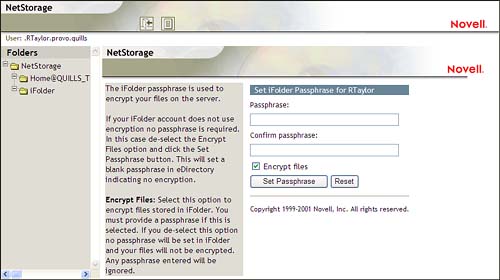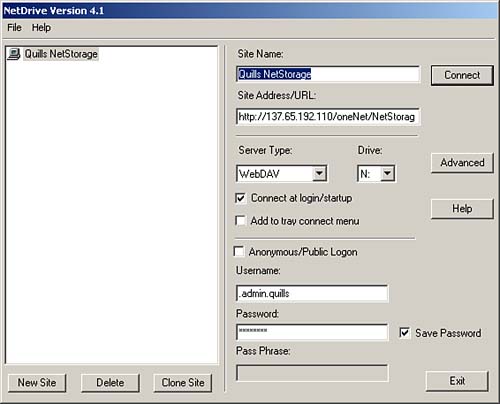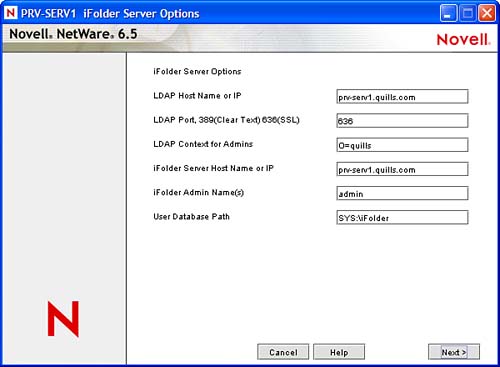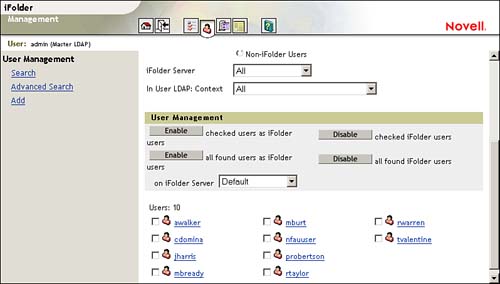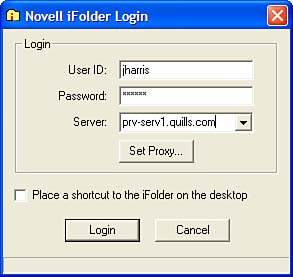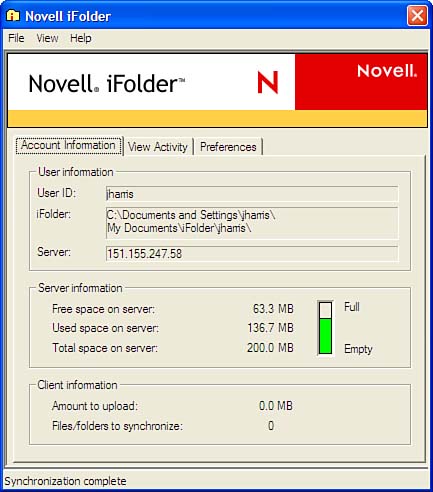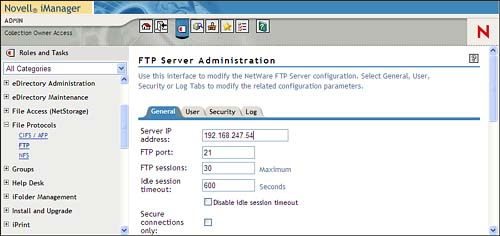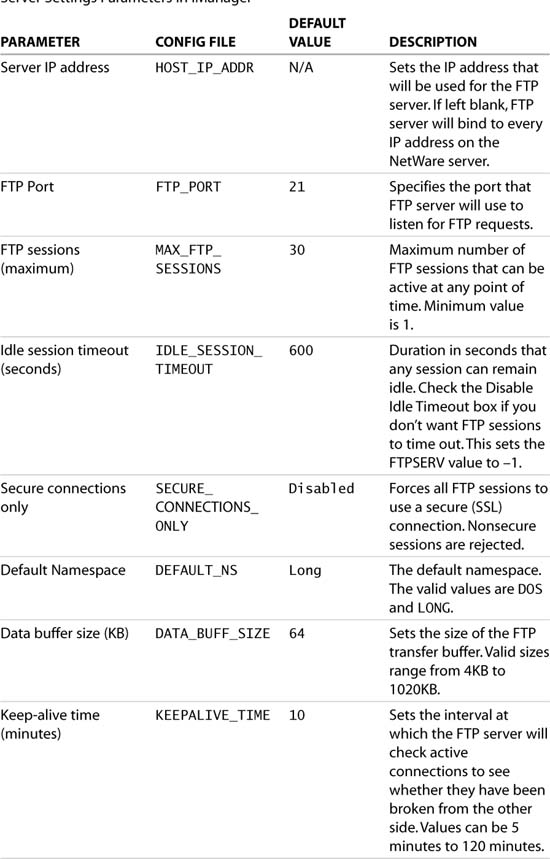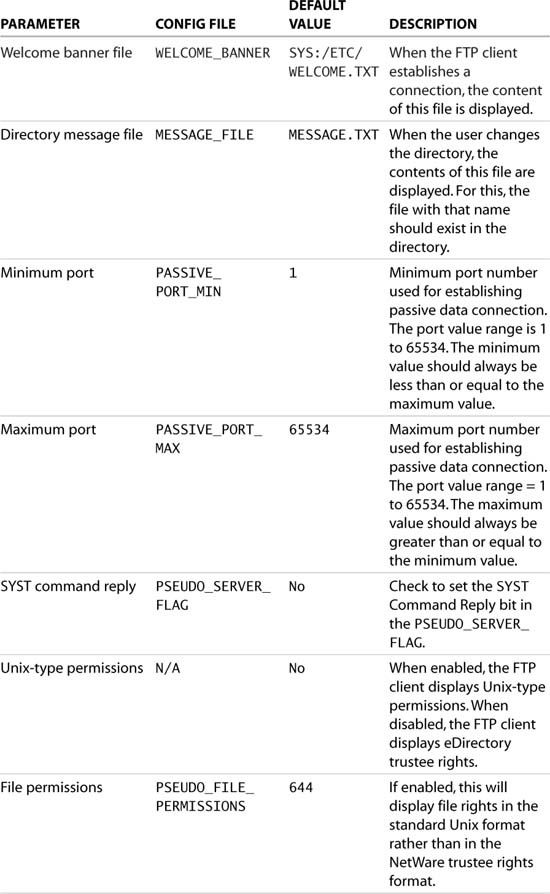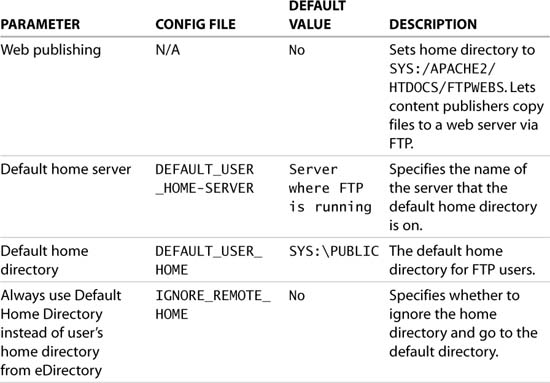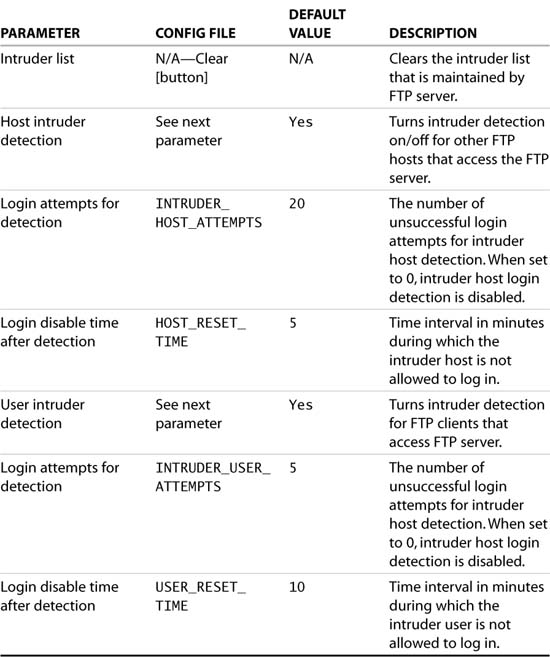![]() NetStorage provides a WebDAV server interface for all OES NetWare files and directories.
NetStorage provides a WebDAV server interface for all OES NetWare files and directories.
![]() Use any WebDAV-compliant application, such as web browsers, Windows Explorer (My Network Places), or Office 2000 to access OES NetWare files and folders.
Use any WebDAV-compliant application, such as web browsers, Windows Explorer (My Network Places), or Office 2000 to access OES NetWare files and folders.
![]() NetStorage can provide clientless access to iFolder files.
NetStorage can provide clientless access to iFolder files.
![]() NetStorage provides the WebDAV support for the NetDrive client.
NetStorage provides the WebDAV support for the NetDrive client.
![]() NetDrive client is available on-line at http://support.novell.com/servlet/filefinder.
NetDrive client is available on-line at http://support.novell.com/servlet/filefinder.
![]() NetDrive supports access of OES NetWare files and folders using standard protocols: FTP, WebDAV, or iFolder.
NetDrive supports access of OES NetWare files and folders using standard protocols: FTP, WebDAV, or iFolder.
![]() Synchronize files between remote clients and a centralized iFolder server, so that user data is available anytime, from anywhere.
Synchronize files between remote clients and a centralized iFolder server, so that user data is available anytime, from anywhere.
![]() Configure and manage iFolder server through the iFolder management console, available through Web Manager after iFolder is installed.
Configure and manage iFolder server through the iFolder management console, available through Web Manager after iFolder is installed.
![]() Use iFolder client to provide synchronization between the iFolder server and regularly used machines.
Use iFolder client to provide synchronization between the iFolder server and regularly used machines.
![]() If you are using a machine for one-time access, use NetStorage to access the iFolder server without having to synchronize all files.
If you are using a machine for one-time access, use NetStorage to access the iFolder server without having to synchronize all files.
![]() Use NetDrive to access the iFolder server without synchronizing the entire directory. Useful when the desktop application is not WebDAV aware.
Use NetDrive to access the iFolder server without synchronizing the entire directory. Useful when the desktop application is not WebDAV aware.
![]() iFolder access requires that the iFolder server be installed and configured prior to use.
iFolder access requires that the iFolder server be installed and configured prior to use.
One of the major tenets of Novell’s oneNet philosophy is that users should have access to their files and data at anytime, from anywhere. To help you reach this goal, OES NetWare includes a host of methods for accessing network data.
In keeping with Novell’s open standards approach to network services, these access methods are designed to use Internet standards, web browsers, and thin clients, thereby minimizing the need to add large amounts of workstation software to access network resources. Those access methods that do require a client of some sort make installation and configuration as easy as possible, so users can get on with their business.
This chapter takes a look at the new and nontraditional forms of file access available in OES NetWare, including
![]() NetStorage
NetStorage
![]() Novell NetDrive
Novell NetDrive
![]() Novell iFolder
Novell iFolder
![]() NetWare FTP server
NetWare FTP server
NetStorage provides a transparent WebDAV interface to NetWare files. This is probably one of the most exciting OES NetWare features. Effectively, NetStorage enables you to access files on an OES NetWare server without a NetWare client. NetStorage is integrated with iFolder, NetDrive, and Virtual Office to make accessing your network files as easy and seamless as possible—all without using the traditional Novell Client.
NetStorage leverages a middle-tier architecture, also called X-tier, to provide its services. This same architecture is used to support some of the functionality for Novell’s ZENworks line of management solutions.
NetStorage can be installed during the installation of the OES NetWare server, or after the fact through iManager or the graphical server console. Typically, you need to install NetStorage on only one OES NetWare server in your eDirectory tree, or on one server at each geographical site, although very heavy usage might require more than one per site.
To install NetStorage through iManager, complete the following steps:
1. Insert the NetWare 6.5 SP3 CD 1 (Operating System) into your workstation.
2. Launch iManager and open the Install and Upgrade link in the Navigation frame.
3. Select Install NetWare 6.5 Products and then click Remote Product Install in the Content frame.
4. At the Target Server screen, select the server to which you want to install NetStorage and click Next. Authenticate as an Admin user for your eDirectory tree and click OK.
5. At the components screen, click Clear All and select only Novell NetStorage. Click Next.
6. At the Summary screen, click Copy Files. You will be prompted to insert the NetWare 6.5 SP3 CD 2 (Products).
7. At the NetStorage Install screen, specify the required information, and click Next. You can change these settings after the installation through iManager by opening the NetStorage link and selecting Authentication Domains:
![]() Primary eDirectory Server—Specify the DNS name or IP address of a server in your eDirectory tree that hosts a master or a read/write replica of eDirectory. This does not have to be the server where NetStorage is being installed. NetStorage will use this server to authenticate users when they attempt to log in to NetStorage.
Primary eDirectory Server—Specify the DNS name or IP address of a server in your eDirectory tree that hosts a master or a read/write replica of eDirectory. This does not have to be the server where NetStorage is being installed. NetStorage will use this server to authenticate users when they attempt to log in to NetStorage.
Tip
If you want NetStorage to search a specific eDirectory context for user information, you can add that context to the end of the DNS name or IP address, separated by a colon (:). If no context is specified, NetStorage searches the entire eDirectory partition stored on the specified eDirectory server for user information.
![]() (Optional) Alternate eDirectory Server—Specify up to two other eDirectory servers to use for user authentication. These can be different servers entirely, or the same server but a different associated context.
(Optional) Alternate eDirectory Server—Specify up to two other eDirectory servers to use for user authentication. These can be different servers entirely, or the same server but a different associated context.
![]() (Optional) iFolder Server—Specify the DNS name or IP address of your iFolder server, as well as the port number used by the iFolder service. This will make iFolder contents available via NetStorage (WebDAV). More information on iFolder is available later in this chapter.
(Optional) iFolder Server—Specify the DNS name or IP address of your iFolder server, as well as the port number used by the iFolder service. This will make iFolder contents available via NetStorage (WebDAV). More information on iFolder is available later in this chapter.
8. At the Installation Complete screen, click Reboot Server to complete the installation of NetStorage.
You must restart your OES NetWare server after completing the NetStorage installation.
Use iManager to configure and manage your NetStorage environment by opening the File Access (NetStorage) link in the Navigation frame. There really isn’t much in the way of required configuration, but it’s nice to understand the control you do have over NetStorage:
![]() Authentication Domains—This page enables you to add/remove/modify authentication domains to NetStorage. These are eDirectory servers that NetStorage will search for user authentication information.
Authentication Domains—This page enables you to add/remove/modify authentication domains to NetStorage. These are eDirectory servers that NetStorage will search for user authentication information.
![]() Current Sessions—This page shows a list of current NetStorage sessions.
Current Sessions—This page shows a list of current NetStorage sessions.
![]() Files—This page enables you to view the available NetStorage files. You will be required to authenticate as a valid user, and the user must exist in one of the authentication domains defined for this NetStorage server.
Files—This page enables you to view the available NetStorage files. You will be required to authenticate as a valid user, and the user must exist in one of the authentication domains defined for this NetStorage server.
![]() iFolder Storage Provider—This page enables you to review and change basic iFolder parameters that relate to its operation with NetStorage. In most cases you won’t have to change any of these, but they are available if necessary.
iFolder Storage Provider—This page enables you to review and change basic iFolder parameters that relate to its operation with NetStorage. In most cases you won’t have to change any of these, but they are available if necessary.
![]() NetWare Storage Provider—This page enables you to review and change basic parameters related to the use of NetWare mapped drives with NetStorage. In most cases you won’t have to change any of these, but they are available if necessary.
NetWare Storage Provider—This page enables you to review and change basic parameters related to the use of NetWare mapped drives with NetStorage. In most cases you won’t have to change any of these, but they are available if necessary.
![]() NetStorage Options—This page enables you to do some configuration of the XTier server configuration. In most cases you won’t have to change any of these, but they are available, if necessary.
NetStorage Options—This page enables you to do some configuration of the XTier server configuration. In most cases you won’t have to change any of these, but they are available, if necessary.
![]() NetStorage Statistics—This page displays a report with information about server uptime, login failures, number of NetStorage sessions, and so on.
NetStorage Statistics—This page displays a report with information about server uptime, login failures, number of NetStorage sessions, and so on.
![]() Resource Usage—This page shows server resources being used in support of the NetStorage middle-tier server environment. It is useful for keeping track of how server resources are being used for troubleshooting server issues.
Resource Usage—This page shows server resources being used in support of the NetStorage middle-tier server environment. It is useful for keeping track of how server resources are being used for troubleshooting server issues.
![]() WebDAV Provider—This page lists the location of the NetStorage WebDAV provider (
WebDAV Provider—This page lists the location of the NetStorage WebDAV provider (XDAV.NLM) and the location of NetStorage template files used for building the NetStorage web interfaces.
![]() Storage Location—Use the Storage Location links to access pages that create/delete/modify storage location objects in your eDirectory tree. Storage location objects are pointers to NetWare directories that can be given more useful names than those typically seen when looking at NetStorage resources. This is particularly useful for common directories shared by multiple users.
Storage Location—Use the Storage Location links to access pages that create/delete/modify storage location objects in your eDirectory tree. Storage location objects are pointers to NetWare directories that can be given more useful names than those typically seen when looking at NetStorage resources. This is particularly useful for common directories shared by multiple users.
For more detailed information on any of these parameters, see the OES online documentation.
To avoid timestamp issues and confusion over the most current version of a file, Novell recommends that the date and time on the NetStorage server and the WebDAV client be reasonably close, within a few hours of each other.
You can access NetStorage from any WebDAV client. Two of the most obvious are web browsers and Microsoft Windows web folders. However, there are WebDAV clients for Linux and Macintosh systems as well. The following process is equally applicable to those environments:
1. From your WebDAV client, enter the NetStorage URL, which is the DNS name or IP address of your NetStorage server with /oneNet/NetStorage appended to the end. Remember to include the http:// prefix and remember that URLs are case sensitive. For example:
http://prv-serv1.quills.com/oneNet/NetStorage
Note
To use web folders in Windows XP/2000, open My Network Places (the Windows WebDAV client) and select Add Network Place. This opens a wizard for creating a new folder in My Network Places.
2. At the authentication screen, specify your eDirectory username and password. This user object must be accessible from the eDirectory server(s) you specified during the NetStorage installation.
When authenticated, your WebDAV client displays the network files and folders that are currently accessible. To do this, NetStorage reads the user’s NetWare login script to determine drive mappings, reads eDirectory user object properties to determine the path to the user’s home directory, and then displays a list of files and folders based on mapped drives and home directories. Figure 12.1 shows NetStorage views from both a web browser and Windows web folders.
Tip
If you specified eDirectory servers from different eDirectory trees during the NetStorage installation, NetStorage will read the user login script from only the primary eDirectory server when calculating mapped drives to display. However, NetStorage will read user object properties from all trees and display multiple home directories—as long as the user object has the same name in each tree. This is useful if a user normally logs in to more than one eDirectory tree.
If you have an iFolder account, you will see an iFolder folder in addition to your mapped drives and home directory, as shown in Figure 12.1. The first time you open the iFolder folder, all you will see is a file called PASSPHRASE.HTM. To access the contents of your iFolder directory, open PASSPHRASE.HTM, as shown in Figure 12.2, and specify the passphrase of your iFolder account.
This lets NetStorage decrypt your iFolder files so that it can interpret them properly. The passphrase for NetStorage is stored as an encrypted attribute on your user object, so it is not at risk of discovery.
After you are connected to your NetWare files through WebDAV, you have full access to them. You can browse, open, and close folders; copy files to your local drive; and open files with WebDAV-compliant applications such as web browsers, Microsoft Office 2000, and so on.
In addition, if you use Microsoft Windows web folders, you can use all the normal Windows mechanisms for copying, cutting, pasting, and renaming files. To perform similar actions from a browser interface, click the Down arrow next to the file or folder with which you want to work.
If you need to use a file with a non-WebDAV application, you will need to copy the file to your local drive so that the application can use normal operating system mechanisms for working with the file. This is the only real drawback to NetStorage: It does not provide low-level integration with the operating system, such as creating a drive letter that enables applications to access the files as if they were local.
Novell helps you resolve this issue for Windows workstations with NetDrive, which is described in the next section. The trade-off is having full access to network files as if they were local versus having a clientless solution for accessing your network files.
Novell NetDrive enables you to map a network drive to any OES NetWare server without using Novell client software. This means that with NetDrive, you can access and modify your files from any workstation using just an Internet connection. After a network drive is mapped, the drive letter that you assigned during the mapping appears in Windows Explorer and functions just like those that are mapped through Novell client. Basically, the capability to map drives has been extracted from the Novell client, where it can be used independent of all the other Novell client features. For more information on the Novell client, see Chapter 3, “OES NetWare Clients.”
NetDrive runs on any Windows workstation, including Windows 95/98/Me and Windows XP/2000/NT. You need only 2MB of available space on your hard drive to install and run the NetDrive client.
Warning
If you are installing the NetDrive client on a Windows 95 workstation, make sure you have installed the Winsock 2 update from Microsoft. It is available on the Microsoft website.
NetDrive supports three protocols for accessing network files:
![]() WebDAV—NetDrive integrates with NetStorage to provide a comprehensive file-access solution with very little client overhead. NetStorage must be installed and configured prior to using NetDrive with WebDAV.
WebDAV—NetDrive integrates with NetStorage to provide a comprehensive file-access solution with very little client overhead. NetStorage must be installed and configured prior to using NetDrive with WebDAV.
![]() FTP—NetDrive can access network files using the standard File Transfer Protocol (FTP). An FTP server must be installed and configured on your network before using NetDrive with FTP. You can use the NetWare FTP server, described earlier in this chapter, to provide this type of access.
FTP—NetDrive can access network files using the standard File Transfer Protocol (FTP). An FTP server must be installed and configured on your network before using NetDrive with FTP. You can use the NetWare FTP server, described earlier in this chapter, to provide this type of access.
![]() iFolder—NetDrive can access files from your directory on the iFolder server. iFolder must be installed, and your iFolder account configured, prior to using NetDrive with iFolder.
iFolder—NetDrive can access files from your directory on the iFolder server. iFolder must be installed, and your iFolder account configured, prior to using NetDrive with iFolder.
The choice of protocol depends largely on your network environment. One is not preferable to another. Use the protocol that best fits your network strategy.
The latest version of the NetDrive client is available at http://support.novell.com/filefinder. If you need help installing the NetDrive client, see Chapter 3.
With the NetDrive client installed, you can access files on your OES NetWare servers using standard Internet protocols. However, not every protocol is supported on every version of Windows:
![]() iFolder—Windows NT and XP/2000
iFolder—Windows NT and XP/2000
![]() FTP—Windows 95, 98, NT, and XP/2000
FTP—Windows 95, 98, NT, and XP/2000
![]() WebDAV (HTTP)—Windows 95, 98, NT, and XP/2000
WebDAV (HTTP)—Windows 95, 98, NT, and XP/2000
![]() Secure WebDAV (SSL)—Windows NT and XP/2000
Secure WebDAV (SSL)—Windows NT and XP/2000
The NetDrive installation inserts an icon in the Windows system tray (lower-right corner of the Explorer window). To configure NetDrive and begin using it to access your network files, complete the following steps:
1. Click the NetDrive icon in the system tray.
2. From the main NetDrive window, as shown in Figure 12.3, you can create new sites, map network drives, and configure and manage the websites to which you have mapped drives.
Each of these functions is discussed in the following sections.
This makes an OES NetWare site available to NetDrive so that drive mapping can take place. To add a site to NetDrive, complete the following steps:
1. In the main NetDrive window, click New Site.
2. At the Add New Site screen, enter the requested information, and click Finish:
![]() Name for your new site—Enter a descriptive name for the new NetDrive site.
Name for your new site—Enter a descriptive name for the new NetDrive site.
![]() Address/URL—For an FTP connection, specify the DNS name or IP address of your FTP server (
Address/URL—For an FTP connection, specify the DNS name or IP address of your FTP server (ftp://ftp.quills.com/files). For a WebDAV connection, specify the DNS name or IP address of the server where NetStorage is installed, along with the NetStorage access path (http://prv-serv1.quills.com/oneNet/NetStorage). For iFolder, specify the DNS name or IP address of your iFolder service (http://ifolder.quills.com). If you omit the FTP or HTTP prefix, NetDrive defaults to FTP. If you want to use a nonstandard HTTP port, make sure you append it to the end of the URL.
Note
If you want to connect with WebDAV and SSL encryption, remember to specify the HTTPS prefix as part of the URL.
After you have created a site, the name of the new site and the URL of the OES NetWare server are listed in the main NetDrive window. The rest of the page defaults to common connection options for the file protocol you have chosen (refer to Figure 12.3). However, you can change any of this information after the fact:
![]() Server Type—Specify the protocol that you will use to access this site.
Server Type—Specify the protocol that you will use to access this site.
![]() Drive—Specify the drive letter that you want to use for the mapped drive.
Drive—Specify the drive letter that you want to use for the mapped drive.
![]() Connect at Login/Startup—Check this box to have NetDrive map its drive automatically when your workstation starts.
Connect at Login/Startup—Check this box to have NetDrive map its drive automatically when your workstation starts.
![]() Add Tray Connect Menu—If you right-click the NetDrive icon in the system tray, you will see a Connect To option. Check this box to add the site to those listed in the Connect To menu.
Add Tray Connect Menu—If you right-click the NetDrive icon in the system tray, you will see a Connect To option. Check this box to add the site to those listed in the Connect To menu.
![]() Anonymous/Public Logon—Check this box to bypass user authentication for an FTP connection. Both WebDAV and iFolder access require specific user authentication. Leave this box unchecked if you want to require authentication to access the site. If you do this, you will have to enter a valid username and password.
Anonymous/Public Logon—Check this box to bypass user authentication for an FTP connection. Both WebDAV and iFolder access require specific user authentication. Leave this box unchecked if you want to require authentication to access the site. If you do this, you will have to enter a valid username and password.
![]() (Conditional) Passphrase—If you are connecting to an iFolder server, enter a passphrase. This is used to encrypt your files as they are transferred over the Internet. iFolder is discussed later in this chapter.
(Conditional) Passphrase—If you are connecting to an iFolder server, enter a passphrase. This is used to encrypt your files as they are transferred over the Internet. iFolder is discussed later in this chapter.
![]() Save Password—Check this box if you want NetDrive to remember your authentication password.
Save Password—Check this box if you want NetDrive to remember your authentication password.
Click the Advanced button to set optional download, caching, and file-locking parameters for the NetDrive site. You won’t normally have to do anything in the Advanced area.
When you are finished configuring site properties, click Connect to map the drive. When NetDrive maps the drive, Windows opens a new window corresponding to the drive letter that you have just mapped.
When NetDrive has successfully mapped a drive to the site, the Monitor window appears. It provides you with connection status, file transfer statistics, and a connection log. With the newly mapped drive, you can copy, cut, and paste files as you would in any other Windows drive.
Tip
If you have problems viewing the mapped directory or connecting to a server using FTP, specify the server IP address instead of the URL. You might also need to enable passive mode if the problem does not go away. Click Advanced and select PASV–Passive Mode. Then try connecting to the web server again.
For more information on the advanced options available with NetDrive, see the OES online documentation.
Novell iFolder gives you automatic, secure, and transparent synchronization of files between your hard drive and the iFolder server, which results in easy access to personal files anywhere, anytime.
Being able to access your files from any computer, in any location, eliminates mistakes and the updating that is frequently necessary when your local files are not accessible over the network.
There are three components to Novell iFolder:
![]() iFolder server software—After you have installed the iFolder server software on your server, users can install the iFolder client to access their iFolder files. Administrators use the iFolder Management console and the iFolder website to manage iFolder user accounts.
iFolder server software—After you have installed the iFolder server software on your server, users can install the iFolder client to access their iFolder files. Administrators use the iFolder Management console and the iFolder website to manage iFolder user accounts.
Note
The iFolder Management console enables you to perform administrative tasks for all iFolder user accounts. From the iFolder website, iFolder users download the iFolder client. It is also where you can access the Java applet and view your iFolder files from a browser. The iFolder website can, and should, be customized to fit the look and feel of your organization.
![]() iFolder client software—Novell iFolder client is compatible with Windows 95/98 and Windows XP/2000/NT workstations. The iFolder client must be installed on every workstation that you will use to access your iFolder files. When the iFolder client is installed, it does three things:
iFolder client software—Novell iFolder client is compatible with Windows 95/98 and Windows XP/2000/NT workstations. The iFolder client must be installed on every workstation that you will use to access your iFolder files. When the iFolder client is installed, it does three things:
![]() It creates a shortcut to your iFolder directory on your desktop. The iFolder directory, which by default is located in
It creates a shortcut to your iFolder directory on your desktop. The iFolder directory, which by default is located in My Documents iFolderuseridHome, is where you will keep the files you want to synchronize with the iFolder server. When a file is placed in the iFolder directory, it is synchronized out to the iFolder server, from which it can be accessed by all workstations that are logged in to your iFolder account.
![]() An iFolder icon is placed in the workstation system tray. Right-clicking the system tray icon gives users access to their user-configurable preferences and the iFolder status screen, which displays a history of the transactions that have occurred between the iFolder server and the client.
An iFolder icon is placed in the workstation system tray. Right-clicking the system tray icon gives users access to their user-configurable preferences and the iFolder status screen, which displays a history of the transactions that have occurred between the iFolder server and the client.
![]() A user account is created on the iFolder server. iFolder user accounts are created automatically when a user downloads and installs the iFolder client. When you log in, iFolder asks you for a username and a password. Next, iFolder prompts you for a passphrase. This passphrase is used to encrypt files that are uploaded to the server.
A user account is created on the iFolder server. iFolder user accounts are created automatically when a user downloads and installs the iFolder client. When you log in, iFolder asks you for a username and a password. Next, iFolder prompts you for a passphrase. This passphrase is used to encrypt files that are uploaded to the server.
Note
Uninstalling the iFolder client does not delete the associated user account on the iFolder server. This can be done only from the iFolder Management console.
![]() iFolder Java applet—Use the iFolder Java applet to access iFolder files from a workstation on which the iFolder client is not installed.
iFolder Java applet—Use the iFolder Java applet to access iFolder files from a workstation on which the iFolder client is not installed.
Remember the following prerequisites when you are installing iFolder:
![]() iFolder requires Internet Explorer 5.5 to be installed on every Windows workstation where you are installing the iFolder client.
iFolder requires Internet Explorer 5.5 to be installed on every Windows workstation where you are installing the iFolder client.
![]() You need 10MB of free space on the
You need 10MB of free space on the SYS: volume where you plan to install iFolder.
![]() Novell provides an iFolder client for both Windows and Linux desktops. For more information on configuring iFolder on a Linux desktop, see the OES online documentation.
Novell provides an iFolder client for both Windows and Linux desktops. For more information on configuring iFolder on a Linux desktop, see the OES online documentation.
Novell iFolder can be installed as part of the OES NetWare server installation, or it can be installed after the fact through either iManager or the graphical server console. To install iFolder with iManager, complete the following steps:
1. Insert the NetWare 6.5 SP3 CD 1 (Operating System) into your workstation.
2. Launch iManager and open the Install and Upgrade link in the Navigation frame.
3. Select Install NetWare 6.5 Products and then click Remote Product Install in the Content frame.
4. At the Target Server screen, select the server to which you want to install iFolder and click Next. Authenticate as an Admin user for your eDirectory tree and click OK.
5. At the Components screen, click Clear All and select only Novell iFolder Storage Services. Click Next.
6. At the Summary screen, click Copy Files. You will be prompted to insert the NetWare 6.5 SP3 CD 2 (Products).
7. At the iFolder Server Options screen, as shown in Figure 12.4, provide the required information and click Next:
![]() LDAP Hostname or IP—Enter the hostname or IP address of the eDirectory server that will authenticate your iFolder users. This server must have a replica of your eDirectory root partition.
LDAP Hostname or IP—Enter the hostname or IP address of the eDirectory server that will authenticate your iFolder users. This server must have a replica of your eDirectory root partition.
![]() LDAP Port—Enter the LDAP port you want to use. Use the default LDAP port (
LDAP Port—Enter the LDAP port you want to use. Use the default LDAP port (389) for unencrypted communications or port 636 for SSL-encrypted communications. If you use port 389, make sure that your LDAP environment allows clear text passwords. Similarly, if you use port 636, make sure that your LDAP server is configured to support SSL.
Tip
Unencrypted LDAP communications (port 389) is a good choice if iFolder and LDAP are running on the same server, and no LDAP communications have to cross the network. For more information on LDAP configuration, see Chapter 6, Novell eDirectory.”
![]() LDAP Context for Admins—Specify the context for all Admin users who need rights to modify iFolder user account information.
LDAP Context for Admins—Specify the context for all Admin users who need rights to modify iFolder user account information.
![]() iFolder server Hostname or IP—Specify the domain name or IP address of the server on which iFolder services will be running.
iFolder server Hostname or IP—Specify the domain name or IP address of the server on which iFolder services will be running.
![]() iFolder Admin name(s)—Specify the user objects that will act as iFolder administrators. Separate multiple names with semicolons, but no spaces.
iFolder Admin name(s)—Specify the user objects that will act as iFolder administrators. Separate multiple names with semicolons, but no spaces.
![]() User Database Path—Enter the path to the directory where you want the iFolder user data to be stored on the iFolder server.
User Database Path—Enter the path to the directory where you want the iFolder user data to be stored on the iFolder server.
At the Installation Complete screen, click Reboot Server to complete the installation of iFolder.
The first time the iFolder client is installed, a user account is automatically created on your iFolder server. In addition to the default iFolder website, another website is available for performing server management.
After iFolder is installed, you can access the iFolder Management console through the following URL: https://<iFolder server DNS or IP address>/iFolderServer/Admin. For example:
https://prv-serv1.quills.com/iFolderServer/Admin
The initial view of iFolder Management console shows you the types of tasks you can perform, but you won’t be able to do anything until you log in via LDAP. Use an administrative user account you specified during the iFolder installation. When authenticated, you will get a new authenticated view of iFolder Management console that enables you to perform the various iFolder administrative tasks (see Figure 12.5). There are four types of iFolder management activities:
![]() Global settings
Global settings
![]() User management
User management
![]() System monitoring
System monitoring
![]() Reporting
Reporting
This is the default page when you first log in to the iFolder Management console. You will see five links in the Navigation frame (see Figure 12.5):
![]() General Info—The General Info link provides basic information about the iFolder server, including DNS name or IP address, port being used, and so on.
General Info—The General Info link provides basic information about the iFolder server, including DNS name or IP address, port being used, and so on.
![]() Global Policies—With the Global Policies page, you can set both server and client policies by clicking the appropriate button. These settings define the default configuration for the iFolder environment.
Global Policies—With the Global Policies page, you can set both server and client policies by clicking the appropriate button. These settings define the default configuration for the iFolder environment.
![]() Admin Names—This page enables you to modify the list of Admin objects defined for iFolder. These objects must be located in the Admin context defined during the installation of iFolder.
Admin Names—This page enables you to modify the list of Admin objects defined for iFolder. These objects must be located in the Admin context defined during the installation of iFolder.
![]() User LDAPs—The User LDAPs page enables you to define the LDAP server that iFolder will use to authenticate users. By default, iFolder will not search subcontexts for potential iFolder users. You can configure the contexts that iFolder should search for users on this page.
User LDAPs—The User LDAPs page enables you to define the LDAP server that iFolder will use to authenticate users. By default, iFolder will not search subcontexts for potential iFolder users. You can configure the contexts that iFolder should search for users on this page.
![]() iFolder Servers—This page enables you to add new iFolder servers to the iFolder environment as they are installed.
iFolder Servers—This page enables you to add new iFolder servers to the iFolder environment as they are installed.
Use the global settings links to configure the primary characteristics of your iFolder environment.
Before your users can start using iFolder, you have to enable their user objects from the User Management button in the iFolder Server Management console. You can select users individually or in groups. To enable user objects to work with iFolder, complete the following steps:
1. Launch iFolder Server Management and click the User Management button in the Header frame.
2. Click Advanced Search in the Navigation frame.
3. Specify how you want iFolder to search for users and then click Search. You can search by a name, a portion of a name, the context, or even the entire server. After you perform the search, all user objects located within your defined criteria will be listed (see Figure 12.6).
4. Click Enable All Found Users as iFolder Users to allow the user objects that have been found to use iFolder. Alternatively, you can check the boxes next to only those user objects for which you want to provide iFolder access and click Enable Checked Users as iFolder Users.
The System Monitoring button provides a real-time view of the status of your iFolder environment. From this page, you can see a list of all iFolder and LDAP servers in your environment, along with important characteristics of each.
The Reporting button enables you to take the information you can see from System Monitoring and capture it in report format. You can create reports in four categories:
![]() General Information—This report gives you information about the status of your entire iFolder environment.
General Information—This report gives you information about the status of your entire iFolder environment.
![]() iFolder Servers—This report provides configuration information for each iFolder server in your environment.
iFolder Servers—This report provides configuration information for each iFolder server in your environment.
![]() User LDAPs—This report provides configuration information for each LDAP server being used by your iFolder environment for user authentication.
User LDAPs—This report provides configuration information for each LDAP server being used by your iFolder environment for user authentication.
![]() User Accounts—This report provides information about each user object that is using your iFolder environment and how it is making use of iFolder resources.
User Accounts—This report provides information about each user object that is using your iFolder environment and how it is making use of iFolder resources.
You can configure the iFolder reporting environment to fit the needs of your network environment.
After iFolder is installed and configured on the server and user access has been defined, your users can begin to take advantage of iFolder’s file synchronization capabilities. The first thing iFolder users need to do is install the iFolder client. The iFolder client is available on the iFolder web page, which is http://<iFolder server DNS or IP address>/iFolder. For example:
http://prv-serv1.quills.com/iFolder
To install the iFolder client, complete the following steps:
1. From the iFolder web page, select Download Windows Client in the Navigation frame. You can download the Linux client for use with Linux desktops as well. For more information on using iFolder with Linux, see the OES online documentation.
2. At the File Download screen, choose to either save the client file to disk or run it directly from the server, and then click OK. If you are accessing the server from a remote location, it will probably be faster to download the file prior to installing the iFolder client. If you do this, specify a location for the file. After the download is complete, execute the file you downloaded.
3. At the Welcome screen, click Next.
4. At the License Agreement Language screen, select the language in which to view the license agreement and click Next. This will open a browser window with the iFolder license agreement. To continue the installation, close the browser window.
5. At the License Agreement screen, click Yes to accept the agreement.
6. At the Destination Location screen, specify the location where you want the iFolder client files to be installed and click Next.
7. At the Installation Complete screen, select Yes, I Want to Restart My Computer Now and click Finish.
8. After your workstation reboots, you will see a Setup Complete message, with instructions on using iFolder. Click Continue to finish the installation.
9. The Login screen will be displayed, as shown in Figure 12.7. Specify the required information and click Login. You will provide a username (typically your NetWare username) and password. Typically, the iFolder server information will be provided for you.
10. At the iFolder Location screen, specify the location on your local drive to which your iFolder files will be synchronized and click OK.
11. At the iFolder configuration screen, make your selections and click OK:
![]() Enable automatic login at startup—Select this option if you want iFolder to start automatically when you boot up your computer.
Enable automatic login at startup—Select this option if you want iFolder to start automatically when you boot up your computer.
![]() Encrypt Files—Select this option if you want to encrypt files that are stored on the iFolder server.
Encrypt Files—Select this option if you want to encrypt files that are stored on the iFolder server.
12. (Conditional) If you elected to encrypt files, specify a passphrase. The passphrase is used as a cryptographic key to encrypt your files on the iFolder server. You can also specify a hint to help remember the passphrase should you forget it.
13. Select Enable passphrase recovery if you want your admin to be able to recover your passphrase for you. Click OK.
After you log in, you will see new iFolder icons on your desktop and in the Windows system tray (lower-right corner of the desktop). The desktop icon is a shortcut to your iFolder files. The system tray icon gives you access to iFolder user account information and configuration parameters. To do this, right-click the iFolder icon that appears on the system tray of your workstation. The following major menu options are available:
![]() Logout/login—If currently logged in, the Logout option is displayed, which will log you off of the iFolder server and stop all iFolder synchronization. If currently logged out, the Login option is displayed, which enables you to log in to the iFolder and initiate synchronization activities.
Logout/login—If currently logged in, the Logout option is displayed, which will log you off of the iFolder server and stop all iFolder synchronization. If currently logged out, the Login option is displayed, which enables you to log in to the iFolder and initiate synchronization activities.
![]() Sync Now—Forces synchronization between the workstation and the iFolder server to begin immediately.
Sync Now—Forces synchronization between the workstation and the iFolder server to begin immediately.
![]() Account Information—This option enables you to view account settings and synchronization activity, as well as enables you to set account synchronization preferences. The Account Information screen is shown in Figure 12.8. From the Account Information screen, you can do the following:
Account Information—This option enables you to view account settings and synchronization activity, as well as enables you to set account synchronization preferences. The Account Information screen is shown in Figure 12.8. From the Account Information screen, you can do the following:
![]() Account Information tab—Displays basic account information, including username, iFolder directory location, iFolder servername, account space statistics, and to-be-synchronized statistics.
Account Information tab—Displays basic account information, including username, iFolder directory location, iFolder servername, account space statistics, and to-be-synchronized statistics.
![]() View Activity tab—Enables you to view, save, and clear your iFolder account activity log. The log is automatically cleared each time you log in to iFolder.
View Activity tab—Enables you to view, save, and clear your iFolder account activity log. The log is automatically cleared each time you log in to iFolder.
![]() Preferences tab—Enables you to enable/disable automatic synchronization and define how often files will be synchronized to/from the iFolder server. You can also choose to have the iFolder client remember your iFolder password and passphrase so that you don’t have to type them each time you log in.
Preferences tab—Enables you to enable/disable automatic synchronization and define how often files will be synchronized to/from the iFolder server. You can also choose to have the iFolder client remember your iFolder password and passphrase so that you don’t have to type them each time you log in.
![]() Open iFolder—Opens the iFolder directory associated with your iFolder client account. This is equivalent to double-clicking the iFolder icon that is created, by default, on the Windows desktop.
Open iFolder—Opens the iFolder directory associated with your iFolder client account. This is equivalent to double-clicking the iFolder icon that is created, by default, on the Windows desktop.
![]() View Conflict Bin—The conflict bin exists to save files that were deleted or changed during an iFolder synchronization. You can manually review the files in the conflict bin to make sure that the correct version of the file has been synchronized.
View Conflict Bin—The conflict bin exists to save files that were deleted or changed during an iFolder synchronization. You can manually review the files in the conflict bin to make sure that the correct version of the file has been synchronized.
![]() About iFolder—Provides version information for the iFolder client.
About iFolder—Provides version information for the iFolder client.
![]() iFolder Web Site—Selecting this option opens the iFolder website associated with your iFolder server. From this page, you can download the iFolder client, view iFolder product information and instructions, and access your iFolder account via a web browser.
iFolder Web Site—Selecting this option opens the iFolder website associated with your iFolder server. From this page, you can download the iFolder client, view iFolder product information and instructions, and access your iFolder account via a web browser.
![]() Help—Opens the iFolder client help file.
Help—Opens the iFolder client help file.
![]() Exit—This option closes the iFolder client interface and effectively logs you out of the iFolder server. The icon will disappear from the system tray, so to restart the iFolder client, you have to click Start, Programs, Novell iFolder, iFolder Client.
Exit—This option closes the iFolder client interface and effectively logs you out of the iFolder server. The icon will disappear from the system tray, so to restart the iFolder client, you have to click Start, Programs, Novell iFolder, iFolder Client.
As you can see, nearly every feature needed by a user is available through the iFolder icon in the Windows system tray.
iFolder has a browser-based option that eliminates the need for the iFolder client to access files in your account on the iFolder server. With iFolder web access, you can download only the files that you need, as opposed to synchronizing the entire directory. With the iFolder web access, all you need is Internet access to get to your iFolder account.
To access your iFolder account through a web browser, complete the following steps:
1. Open the iFolder Applet, which is found at the following URL: http://<iFolder server DNS or IP address>/iFolder/applet/java.htm.
2. At the Login screen, provide your iFolder username, password, and passphrase and click Connect.
When logged in, you will see your iFolder files, listed in a directory structure in the browser window (see Figure 12.9). Expand folders by double-clicking them.
From the browser interface, you can download, upload, delete, create, and rename files. However, after downloading a file, changes will not be synchronized automatically. Make sure you upload files after making changes, so they can be synchronized to all other workstations where you have installed the iFolder client.
Accessing an iFolder server from either NetStorage or NetDrive was described earlier in this chapter in the sections for each of those products. However, the important thing to remember is that you are accessing files on the server only. You don’t get the effects of synchronization between client and server as you do with the iFolder client.
The advantage of this scenario is that you can access files from any workstation without fear of accidentally leaving data on a foreign machine. This might lead some to consider using iFolder without installing the iFolder client. This is a possible solution, but remember that files are not replicated to multiple locations. If the server experienced a problem, files on the iFolder server could become lost or unrecoverable.
NetWare FTP server is based on the standard ARPANET file transfer protocol that runs over TCP/IP and conforms to RFC 959. You can perform file transfers from any FTP client by using the FTP server to log in to the Novell eDirectory tree.
FTP server is a fully functional FTP with many features, such as those in the following list. This section provides basic installation and configuration information so you can use FTP file access with NetDrive:
![]() iManager-based management—Use iManager to start and stop FTP server and configure server, security, user, and log settings. For more information on iManager, see Chapter 3.
iManager-based management—Use iManager to start and stop FTP server and configure server, security, user, and log settings. For more information on iManager, see Chapter 3.
![]() Run multiple copies of FTP server—Multiple instances of NetWare FTP server software can be loaded on the same NetWare server, providing different FTP services to different sets of users.
Run multiple copies of FTP server—Multiple instances of NetWare FTP server software can be loaded on the same NetWare server, providing different FTP services to different sets of users.
![]() FTP access restrictions—FTP access can be restricted at various levels through comprehensive access rights controls.
FTP access restrictions—FTP access can be restricted at various levels through comprehensive access rights controls.
![]() Intruder detection—Intruder hosts or users who try to log in using an invalid password can be detected and restricted.
Intruder detection—Intruder hosts or users who try to log in using an invalid password can be detected and restricted.
![]() Remote server access—FTP users can navigate and access files from other NetWare servers in the same eDirectory tree, and even from remote IBM servers. Remote servers don’t have to be running an FTP server.
Remote server access—FTP users can navigate and access files from other NetWare servers in the same eDirectory tree, and even from remote IBM servers. Remote servers don’t have to be running an FTP server.
![]() Anonymous user access—Anonymous user accounts can be set up to provide users with basic access to public files.
Anonymous user access—Anonymous user accounts can be set up to provide users with basic access to public files.
![]() Special quote site commands—These are special, NetWare-specific commands used to change or view some NetWare-specific parameters.
Special quote site commands—These are special, NetWare-specific commands used to change or view some NetWare-specific parameters.
![]() Firewall support—If the FTP client is behind a firewall, FTP server supports passive mode data transfer and the configuration of a range of passive data ports.
Firewall support—If the FTP client is behind a firewall, FTP server supports passive mode data transfer and the configuration of a range of passive data ports.
![]() Active sessions display—View details of all active FTP instances in real-time. This includes such information as a list of all instances, details of each instance, all sessions in an instance, and details of individual sessions within an instance.
Active sessions display—View details of all active FTP instances in real-time. This includes such information as a list of all instances, details of each instance, all sessions in an instance, and details of individual sessions within an instance.
![]() Name space support—FTP server supports both DOS and long name spaces. The FTP user can dynamically change the default name space by using one of the quote site commands.
Name space support—FTP server supports both DOS and long name spaces. The FTP user can dynamically change the default name space by using one of the quote site commands.
![]() SNMP error reporting—Simple Network Management Protocol (SNMP) traps are issued when an FTP login request comes from an intruder host or from a node address restricted through Novell eDirectory. SNMP traps can be captured and viewed by any SNMP-compliant management console.
SNMP error reporting—Simple Network Management Protocol (SNMP) traps are issued when an FTP login request comes from an intruder host or from a node address restricted through Novell eDirectory. SNMP traps can be captured and viewed by any SNMP-compliant management console.
![]() FTP logs—The FTP service maintains a log of several activities, including FTP sessions, unsuccessful login attempts, active sessions details, and system error and FTP server-related messages.
FTP logs—The FTP service maintains a log of several activities, including FTP sessions, unsuccessful login attempts, active sessions details, and system error and FTP server-related messages.
![]() Cluster services support—NetWare FTP server can be configured with Novell Cluster Services (NCS) for high availability.
Cluster services support—NetWare FTP server can be configured with Novell Cluster Services (NCS) for high availability.
For detailed information on all FTP server features, see the OES NetWare online documentation.
The FTP server can be installed as an optional component during the OES NetWare installation or it can be installed later through iManager or the graphical server console. To install the FTP server using iManager, complete the following steps:
1. Insert the NetWare 6.5 SP3 CD 1 (Operating System) into your workstation.
2. Launch iManager and open the Install and Upgrade link in the Navigation frame.
3. Select Install NetWare 6.5 Products and then click Remote Product Install in the Content frame.
4. At the Target Server screen, select the server to which you want to install FTP server and click Next. Authenticate as an Admin user for your eDirectory tree and click OK.
5. At the Components screen, click Clear All and select only NetWare FTP Server. Click Next.
6. At the Summary screen click Copy Files. You will be prompted to insert the NetWare 6.5 SP3 CD 2 (Products).
After the FTP server files are copied, click Close to complete the installation.
Before you start the NetWare FTP server software, you should configure it by setting the configuration parameters in the configuration file. The default configuration file is SYS:/ETC/FTPSERV.CFG. The parameters in this configuration file are commented with their default values.
When the NetWare FTP server is started, the IP address of the host (HOST_IP_ADDR) and the port number of the NetWare FTP server (FTP_PORT), as defined in the configuration file, are used to bind to and listen for FTP client connection requests. If these parameters are not defined in the configuration file, the FTP server binds to all configured network interfaces in the server and uses the standard FTP ports.
Multiple instances of the NetWare FTP server can run on a single machine with different IP addresses or port numbers. The various parameters in the configuration file along with the default values are described in the tables presented later in this chapter.
You can use iManager as an access point for administering the NetWare FTP server. To do so, launch iManager and select File Protocols, FTP in the Navigation frame. The FTP server utility is shown in Figure 12.10.
The first time you open the FTP server utility, specify the FTP server in the Server field to populate the FTP Server Instances list. After you have done this, you can manage your FTP server in your environment simply by clicking its link in the FTP Server Administration page. Additional server instances can be added through this page as well.
The FTP server configuration file can be edited manually with any text editor. However, it is much easier to configure and manage FTP server from iManager. iManager also gives you the freedom to manage the FTP server from any network connection and web browser.
From the FTP Server Administration page, you can start and stop the FTP server as necessary. This loads or unloads NWFTPD.NLM on the OES NetWare server running FTP services. You can also select Monitor Active FTP Sessions to view statistics about the currently active FTP sessions.
The server reads the default configuration file SYS:/ETC/FTPSERV.CFG and configures itself accordingly. If there is any change in the FTP configuration file, you should stop and restart the FTP server.
When you select an FTP server instance to manage in iManager, you will see four pages of configuration options (see Figure 12.11). Each provides access to specific types of configuration parameters and information, as described in the following sections.
Click the General tab to access general FTP server settings. When finished, click Save to record your settings or click Reset to revert to the previous settings. Table 12.1 lists the available server settings, with a brief description and the equivalent setting in the configuration file.
Click the User tab to access parameters that control file access and user authentication for FTP server. When finished, click Save to record your settings or click Reset to revert to the previous settings. Table 12.2 lists the available user settings, with a brief description and the equivalent setting in the configuration file.
Click the Security tab to access intruder detection parameters for FTP server. When finished, click Save to record your settings or click Reset to revert to the previous settings. Table 12.3 lists the available security settings, with a brief description and the equivalent setting in the configuration file.
Click the Log tab to access log file parameters for FTP server. All FTP logs are created automatically. You control only the types of messages that are logged and how large the log files will grow. When finished, click Save to record your settings. You can also view current log files by selecting the log you want to see and clicking the View button.
Table 12.4 lists the available log settings, with a brief description and the equivalent setting in the configuration file.
Table 12.4. Log Settings in iManager
|
PARAMETER |
CONFIG FILE |
DEFAULT VALUE |
DESCRIPTION |
|---|---|---|---|
|
Log directory |
|
|
Specifies the directory in which FTP log files will be stored. |
|
Maximum log size (KB) |
|
|
Maximum size to which an FTP log file will grow. Range from 1KB to 4194303KB. |
|
Messages of type |
|
Errors, Warnings, and Information |
Indicates the types of messages that are logged. |
|
Daemon log file |
|
|
Specifies the name of the FTP daemon log file. |
|
Audit log file |
|
|
Specifies the name of the FTP audit log file. |
|
Intruder log file |
|
|
Specifies the name of the FTP intruder log file. |
|
Statistics log file |
|
|
Specifies the name of the FTP statistics log file. |
|
View Log Files |
|
|
To view any of the log files mentioned in Table 10.4, select it from the Log File drop-down menu and click the View button. |
This information will give you an FTP server suitable for use with NetDrive, which was discussed earlier in this chapter. For more information on using an FTP server in more general situations, see the OES online documentation.


